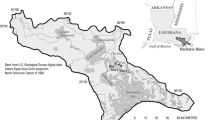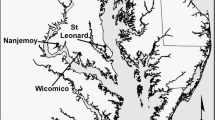Abstract
Sediment was transplanted from a 13-yr-old created wetland on a nonacid mine in east Texas into a constructed experimental basin to examine seed bank response to 4 drawdown regimes. The experimental basin was flooded following sediment transplantation in February, and surface water was later removed in April, June, and August. The success of the transplanted seed bank in vegetating the experimental wetland was assessed by measuring species richness, seedling density, and above-ground biomass. April drawdown produced the greatest species richness (29), stem density (1851.0 stems m−2), and above-ground biomass (769.3 g m−2), followed by the unflooded water regime. June and August drawdowns produced less emergent vegetation than the other treatments, but 3 submergent species were produced prior to drawdowns. Results indicate that use of transplanted species-rich wetland soil subjected to early spring drawdown is a very effective technique for establishing wetland vegetation on disturbed sites in east Texas. In addition, reestablishment of vegetation in the donor wetland was assessed by comparing percent cover in disturbed plots to undisturbed plots. Disturbed plots achieved 66.0 percent cover after 10 months following soil removal compared to 96.3 percent cover in undisturbed plots. Disturbed plots were dominated by vegetatively reproducing species and contained very few annuals. Excavating relatively few widely-spaced narrow strips of soil from the donor wetland caused only slight decreases in vegetative cover during the subsequent growing season.
Similar content being viewed by others
Literature Cited
Brown, M. T. and H. T. Odum. 1985. Studies of a method of wetland reconstruction following phosphate mining. Publ. No. 03-022-032. Florida Institute of Phosphate Research. Barstow, FL, USA.
Correll, D. S. and M. C. Johnston. 1979. Manual of the Vascular Plants of Texas. The University of Texas at Dallas. Dallas, TX, USA.
Cresswell, E. G. and J. P. Grime. 1981. Induction of a light requirement during seed development and its ecological consequences. Nature 291:583–585.
Erwin, K. L. 1990. Freshwater marsh creation and restoration in the Southeast. p. 233–265In J. A. Kusler and M. E. Kentula (eds.) Wetland Creation and Restoration: the Status of the Science. Island Press, Washington, DC, USA.
Frederickson, L. H. and T. S. Taylor. 1982. Management of seasonally flooded impoundments for wildlife. U.S. Fish Wildlife Service, Washington, DC, USA. Resource Publication 125.
Godfrey, R. K. and J. W. Wooten. 1981. Aquatic and Wetland Plants of Southeastern United States. The University of Georgia Press. Athens, GA, USA.
Harris, S. W. and W. H. Marshall. 1963. Ecology of water-level manipulations on a northern marsh. Ecology 44:331–343.
Hartman, J. M.. 1988. Recolonization of small disturbance patches in a New England salt marsh. American Journal of Botany 75:1625–1631.
Hillel, D. 1980. Fundamentals of Soil Physics. Academic Press, Inc., New York, NY, USA.
Hossner, L. R. (ed.). 1980. Reclamation of surface-mined lignite spoil in Texas. Texas Agricultural Experiment Station, College Station, TX, USA. Resource Publication RM-10.
Kusler, J. A. and M. E. Kentula (eds.). 1990. Wetland Creation and Restoration: the Status of the Science. Island Press, Inc., Washington, DC, USA.
Lagler, K. F. 1956. Freshwater Fishery Biology. Second ed. W. C. Brown Company, Dubuque, IA, USA.
Leck, M. A. 1989. Wetland seed banks, p. 283–305In M. A. Leck, V. T. Parker, and R. L. Simpson (eds.) Ecology of Soil Seed Banks. Academic Press, Inc., San Diego, CA, USA.
Martin, A. C., H. S. Zim, and A. L. Nelson. 1951. American Wildlife & Plants: a Guide to Wildlife Food Habits. Dover Publications, Inc., New York, NY, USA.
Mecks, R. L. 1969. The effect of drawdown date on wetland plant succession. Journal of Wildlife Management 33:817–821.
Merendino, M. T. and L. M. Smith. 1991. Influence of drawdown date and reflood depth on wetland vegetation establishment. Wildlife Society Bulletin 19:143–150.
Milton, W. E. J. 1939. The occurrence of buried viable seeds in soils at different elevations and on a salt marsh. Journal of Ecology 27:149–159.
Morinaga, T. 1925a. Effect of alternating temperatures upon the germination of seeds. American Journal of Botany 13:141–158.
Morinaga, T. 1925b. The favorable effect of reduced oxygen supply upon the germination of certain seeds. American Journal of Botany 13:159–166.
Railroad Commission of Texas. 1986. Coal mining regulations. Surface Mining and Reclamation Division, Austin, TX, USA.
Riley, T. Z. and D. M. DeRoia. 1989. Early decomposition and invertebrate colonization of nodding smartweed leaves. Wetlands 9:219–225.
SAS Institute Inc. 1987. SAS/STAT Guide. SAS Institute, Inc., Cary, NC, USA.
Savino, J. F. and R. A. Stein. 1989. Behavioural interactions between fish predators and their prey: effects of plant density. Animal Behaviour 37:311–321
Smith, A. L. 1972. Factors influencing germination ofScolochloa festucacea caryopses. Canadian Journal of Botany 50:2085–2092.
Smith, L. M. and J. A. Kadlec. 1983. Seed banks and their role during drawdown of a North American Marsh. Journal of Applied Ecology 20:673–684.
Snedecor, G. W. and W. G. Cochran. 1967. Statistical Methods. Iowa State University Press, Ames, IA, USA.
Thompson, K. and J. P. Grime. 1979. Seasonal variation in the seed banks of herbaceous species in ten contrasting habitats. Journal of Ecology 67:893–921.
Thompson, K. and J. P. Grime. 1983. A comparative study of germination responses to diurnally-fluctuating temperatures. Journal of Applied Ecology 20:141–156.
van der Valk, A. G. 1981. Succession in wetlands: a Gleasonian approach. Ecology 62:688–696.
van der Valk, A. G. 1986. The impact of litter and annual plants on recruitment from the seed bank of a lacustrine wetland. Aquatic. Botany 24:13–26.
van der Valk, A. G. and R. L. Pederson. 1989. Seed banks and the management and restoration of natural vegetation. p. 329–346In M. A. Leck, V. T. Parker, and R. L. Simpson (eds.) Ecology of Soil Seed Banks. Academic Press, Inc., San Diego, CA, USA.
Author information
Authors and Affiliations
Rights and permissions
About this article
Cite this article
McKnight, S.K. Transplanted seed bank response to drawdown time in a created wetland in East Texas. Wetlands 12, 79–90 (1992). https://doi.org/10.1007/BF03160589
Received:
Revised:
Accepted:
Issue Date:
DOI: https://doi.org/10.1007/BF03160589




